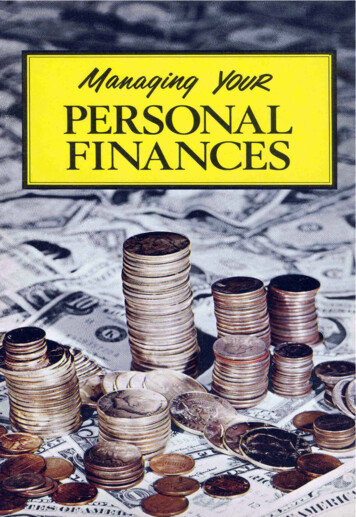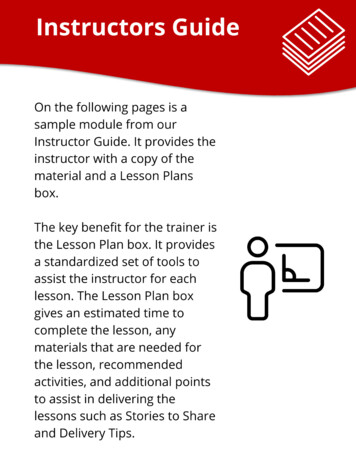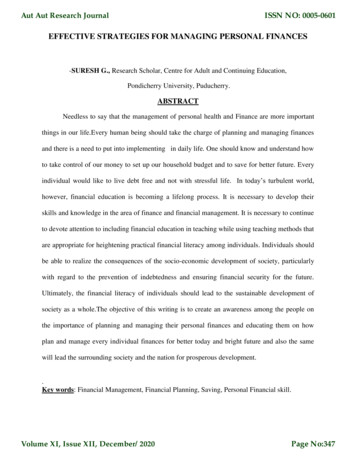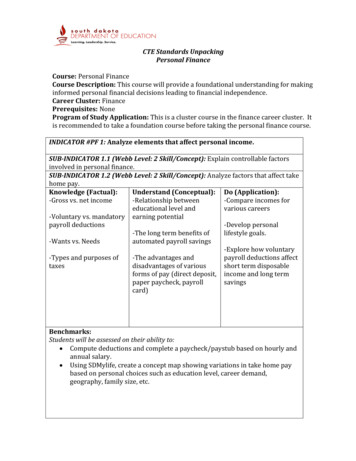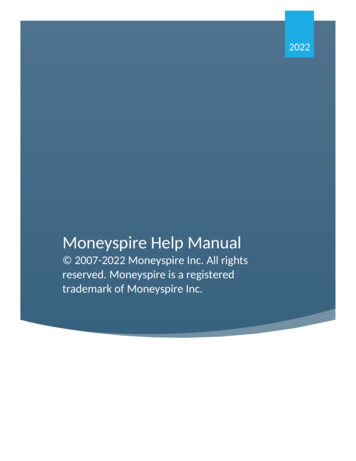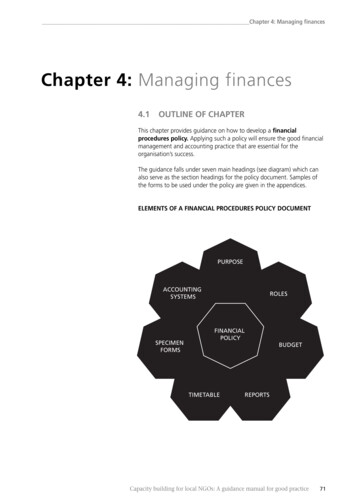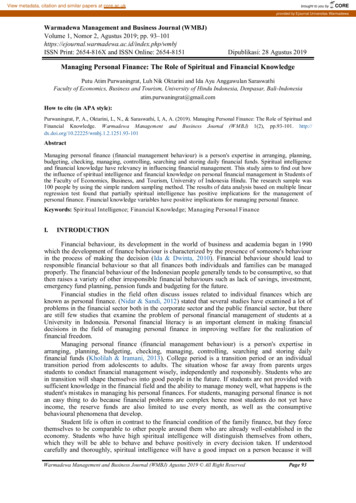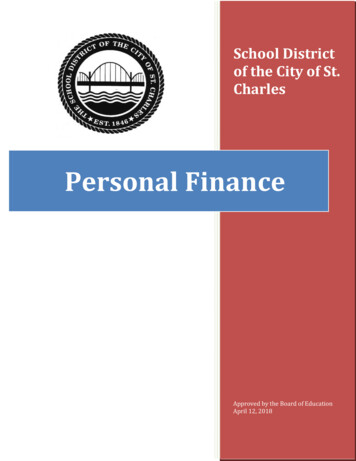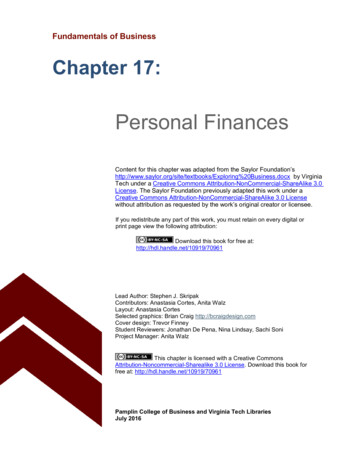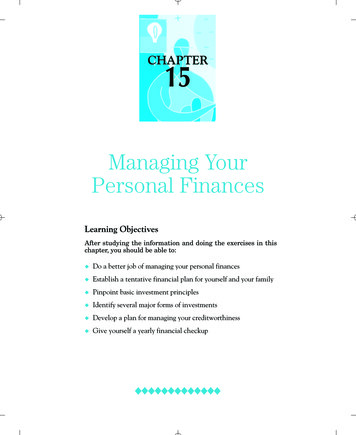
Transcription
CHAPTER15Managing YourPersonal FinancesLearning ObjectivesAfter studying the information and doing the exercises in thischapter, you should be able to: Do a better job of managing your personal finances Establish a tentative financial plan for yourself and your family Pinpoint basic investment principles Identify several major forms of investments Develop a plan for managing your creditworthiness Give yourself a yearly financial checkup
440 CH. 15 MANAGING YOUR PERSONAL FINANCESFor more than a year, Rachel Hulin paid 90 a month for a gym membership. She used it maybe four times in all—for a per-visit rate ofapproximately 315. “I sort of felt like an idiot,” says the 24-year-old photographer. “I think I signed up for it to try to make myself go.” Ms. Hulin laterdropped her expensive membership and joined another, less expensive gymat 55 a month. But she admits she hasn’t “gone in a while” there, either.Hulin is not alone in her casualcontrol of her expenses. Research suggests that consumers often pay toomuch for services, ranging from gymmemberships to movie rental clubs, because the overestimate how often theywill use them.1The brief mention of the womanwho underuses her gym membershipand the supporting research illustratethe importance of managing personalfinances well. People who do scrutinizetheir spending will often be able tosqueeze some money out of expensesand invest that money into othersources of pleasure. Equally important,they will have more money availablefor savings and investments.It is important to manage personal finances in such a way that money becomes a source of satisfaction rather than a major worry. Financial problemscan lead to other problems. Poor concentration stemming from financial worries may lead to low job performance. Many relationship problems stem fromconflict about finances. Worry about money can also drain energy that could beused to advance your career or enrich your personal life.The purpose of this chapter is to present information that should enableyou to start on the road to financial comfort and escape financial discomfort. Our approach is to cover the basics of personal financial planning, investment principles, choosing investments, managing and preventing debt,giving yourself a yearly financial checkup, and retiring rich. YOUR PERSONAL FINANCIAL PLANA highly recommended starting point in improving your present financial condition and enhancing your future is to develop a personal financialplan. Two key elements of a personal financial plan are financial goals anda budget. The spending plan, or budget, helps you set aside the money forinvestments that you need to accomplish your goals. The subject of how toinvest the money your investment plan provides is described at later pointsin this chapter.
YOUR PERSONAL FINANCIAL PLAN 441ESTABLISHING FINANCIAL GOALSPersonal finance is yet another area in which goal setting generallyimproves performance. A common approach to financial goal setting is tospecify amounts of money you would like to earn at certain points in time.An individual might set yearly financial goals, adjusted for inflation. Another might set goals for five-year intervals. Another common financialgoal is to obtain enough money to cover a specific expense, such as making a down payment on a new car. These goals should include a targetdate, such as shown in Exhibit 15-1. An important supplement to establishing these goals is an investment table that specifies the amount ofmoney needed to achieve the goal (see Table 15-1). Financial goals aresometimes expressed in terms of the allocation of money. Among thesegoals would be the following: Putting pay raises into savings or reducing debt Participating in an automatic savings or retirement plan whereby afinancial institution deducts money from each paycheck Investing 10 percent of each net paycheck into a mutual fundFinancial goals are sometimes more motivational when they point tothe lifestyle you hope to achieve with specific amounts of money. In thisway, money becomes the means to the ends that bring satisfaction and happiness. Here are two examples of financial goals expressed in terms of whatmoney can accomplish: By 2009 I want to earn enough money to have my own apartmentand car and buy nice gifts for my family and relatives. By 2033, I want to earn enough money to have paid for my house,own a vacation home near a lake, and take a winter vacationeach year.EXHIBIT 15-1Financial Goal SettingGoal1. Pay off credit cardsTargetDateJune 2005Yearsto Goal11/2DollarsNeeded 5,6752. Pay for son’s collegeSeptember 202518 175,0003. Down payment on homeJune 200941/2 28,000
442 CH. 15 MANAGING YOUR PERSONAL FINANCESTABLE 15-1MONTHLY SAVINGS NEEDED TO REACH GOAL(5% AFTER-TAX RATE OF RETURN)Dollar GoalsYears 5,000 10,000 20,000 50,000 ,189846641242120NOTE: This chart assumes that deposits are made at the beginning of each month and thatinterest is compounded monthly.DEVELOPING A BUDGET (SPENDING PLAN)When most people hear the word budget, they think of a low-priced itemor miserly spending habits. Their perception is only partially correct. Abudget is a plan for spending money to improve your chances of using yourmoney wisely and not spending more than your net income. John Gilligan,the executive director of a consumer credit counseling service, reminds us ofthe important of following a budget. He says that 90 percent of clients do nothave a budget in place or do not know how to develop one when they firstseek his agency’s services.2 Developing a budget can be divided into a seriesof logical steps. Exhibit 15-2 presents a worksheet helpful for carrying outthe plan. Many people today use software that helps you lay out a budget.For most people, a monthly budget makes the most sense because so manyexpenses are once-a-month items.Step 1. Establishing goals. Decide what you or your family reallyneed and want. If you are establishing a family budget, it is best toinvolve the entire family. For the sake of simplicity, we will assumehere that the reader is preparing an individual budget. Individualbudgets can be combined to form the family budget. Goal settingshould be done for the short, intermediate, and long term. A shortterm goal might be “replace hot water heater this February.” Along-term goal might be “accumulate enough money for arecreational vehicle within 10 years.”Step 2. Estimating income. People whose entire income is derivedfrom salary can readily estimate their income. Commissions,bonuses, and investment income are more variable. So is incomefrom part-time work, inheritance, and prizes.
YOUR PERSONAL FINANCIAL PLAN 443EXHIBIT 15-2The Investment Risk PyramidThe investment risk developed landNew/untested stock issuesModerate growthCommon stockGrowth mutual fundsGrowth-and-income fundsVariable life insurance and annuitiesIncomeUnit investment trustsU.S. Treasury bills, notes and bondsCorporate and municipal bonds and bond fundsTry to build your investments in the shape of apyramid with a solid foundation, adding riskierinvestments in proportions appropriate for your age,your budget, and your temperament. In general, thehigher the investment on the pyramid (see below), thegreater the risk—and the greater the potential forreward. (Some investments may fit more than onecategory. An example is variable life insurance, whereyou may make investment choices.)A conservative baseSavings accounts and certificates of depositEE bonds, money market funds, and money market deposit accountsYour house, traditional whole life insurance, and annuitiesSOURCE:Reproduced with permission of The Prudential.Step 3. Estimating expenses. The best way to estimate expenses isto keep close track of what you are actually spending now. Afterlisting all your expenses, perhaps for two weeks, break theexpenses down into meaningful categories such as those shown inExhibit 15-3. Modify the specific items to suit your particularspending patterns. For instance, computer supplies and Internetservice might be such a big item in your spending plan that itdeserves a separate category. It is possible that an expense youhave now will soon decrease (such as paying off a loan) or increase(such as joining a health club).Try to plan for large expenses so that they are spaced atintervals over several years. If you plan to purchase a car one year,plan to remodel your kitchen another. If you buy an overcoat oneseason, you might have to delay buying a suit until the next year.Use your records and recollections to help you decide whetherto continue your present pattern of spending or to make changes.For instance, estimating your expenses might reveal that you arespending far too much on gas for the car. An antidote might be toconsolidate errand-running trips or make some trips by foot orbicycle.
EXHIBIT 15-3Your Monthly Spending PlanMonthly ExpensesMonthly IncomeFixed:Mortgage or rentProperty insuranceHealth insuranceAuto insuranceOther insuranceEducational expensesChild support paymentsLocal telephone and Internetservice providerCable or satellite TVSummary:Variable:FoodHousehold suppliesHome maintenanceMedical and dentalToll calls and cell phoneClothingHair care and cosmeticsTransportationCar maintenanceEntertainment includingpay-for-view TVTravel and vacationClubs/organizationsHobbiesOtherTotal expenses444Taxes:FederalState or provincialSocial SecurityLocalPropertyInstallment loans(auto and others)Set-aside for emergenciesSalaryTipsBonuses and commissionsInterest and dividendsInsurance benefitsChild support receivedOtherTotal incomeTotal incomeLess total expensesBalance for savingsand investment
BASIC INVESTMENT PRINCIPLES 445Step 4. Comparing expenses and income. Add the figures in yourspending plan. Now compare the total with your estimate ofincome for the planning period. If the two figures balance, at leastyou are in neutral financial condition. If your income exceeds yourestimate of expenses, you may decide to satisfy more of yourimmediate wants, set aside more money for future goals, or put thebalance into savings or investment.Remember that the true profit from your labor is the differencebetween your net income and your total expenses. Set-asides areconsidered an expense since you will inevitably use up that moneyto meet future goals or pay for seasonal expenses. Without amiscellaneous category, many budgets will project a profit thatnever materializes. Any household budget has some miscellaneousor unpredictable items each month. After working with yourbudget several months, you should be able to make an accurateestimate of miscellaneous expenses.If your income is below your estimated expenses, you will haveto embark on a cost-cutting campaign in your household. If youbrainstorm the problem by yourself or with friends, you will comeup with dozens of valid expense-reducing suggestions.Step 5. Carrying out the budget. After you have done your best jobof putting your spending plan on paper or hard drive, try it out forone, two, or three months. See how close it comes to reality. Keepaccurate records to find out where your money is being spent. It ishelpful to make a notation of expenditures at the end of every day.Did you forget about that 29 you spent on party snacks Sundayafternoon? It is a good idea to keep all financial records together.You may find it helpful to set aside a desk drawer, a large box, orother convenient place to put your record book, bills, receipts, andother financial papers. Converting paper records into computerizedfiles is strongly recommended for maintaining a spending plan.Step 6. Evaluating the budget. Compare what you spent with whatyou planned to spend for three consecutive months. If yourspending was quite different from your plan, find out why. If yourplan did not provide for your needs, it must be revised. You cannotlive with a spending plan that allows for no food the last four daysof the month. If the plan fitted your needs but you had troublesticking to it, the solution to your problem may be to practice moreself-discipline. Each succeeding budget should work better. Ascircumstances change, your budget will need revision. A budget is achanging, living document that serves as a guide to the propermanagement of your personal finances. BASIC INVESTMENT PRINCIPLESAfter you have developed a spending plan that results in money leftover for savings and investment, you can begin investing. To start developing an investment strategy or refining your present one, consider the eight
446 CH. 15 MANAGING YOUR PERSONAL FINANCESinvestment principles presented next. They are based on the collected wisdom of many financial planners and financially successful people.1. Spend less money than you earn. The key to lifelong financial security and peace of mind is to spend less money than you earn. By so doing,you will avoid the stresses of being in debt and worrying about money. Awidely accepted rule of thumb is to set aside 10 percent of your net incomefor savings and investments. For many people struggling to make endsmeet, the 10 percent rule is unrealistic. These people may choose to implement the 10 percent rule later in their careers. A growing practice is to havesavings and investments deducted automatically from your paycheck orbank account. The automatic plans ensures that you will set aside somemoney each month for investments.2. Invest early and steadily to capitalize on the benefits of compounding.Investments made early in life grow substantially more than those madelater. You will slowly and steadily accumulate wealth if you begin investingearly in life and continue to invest regularly. Let’s look at a straightforwardexample. Assume that you invest 1,000 at the start of each year for fiveyears. It earns 8 percent a year, and the earnings are compounded (interestis paid on the accumulated principal plus the accumulated interest). Youwould have 6,123 at the end of five years. If you invested 1,000 at thestart of each year for 25 years, you would have 79, 252. To achieve thesefull results, you would have to make tax-free, or tax-deferred, investments.3. Keep reinvesting dividends. As implied in the second principle, dividends and interest payments must be reinvested to fully benefit from earlyand regular investments. Here is an illustration based on stock dividends.Assume that a person had invested 5,000 in a representative group of common stocks 35 years ago. The amount accumulated with reinvesting dividends is four times as great as that without reinvesting. The person who didnot reinvest the dividends would have accumulated approximately 60,000,while the person who reinvested the dividends would have stocks worth approximately 240,000.4. Diversify your investments (use asset allocation). A bedrock principle of successful investing is to diversify your investments. This approachis referred to as asset allocation because you allocate your assets to different types of investments. Money is typically apportioned among stocks,bonds, short-term instruments like money market funds, and real estate(including home ownership). A starting point in diversifying your investments is to accumulate enough money in cash or its equivalent to tide youover for three months in case you are without employment. Your specific allocation of assets will depend on your tolerance for risk and your timeframe. At the conclusion of the section on choosing your investments, wewill describe several different investment allocations.5. Maintain a disciplined, long-term approach. If you have an investment plan suited to your needs, stick with it over time. The patient, longterm investor is likely to achieve substantial success. Investors who makeinvestments based on hunches and hot tips and sell in panic when the valueof their investments drop generally achieve poorer returns. A representative study showed that investors held their shares in mutual funds for an
BASIC INVESTMENT PRINCIPLES 447average of 30 months from 1984 through 2002. Along the way, they achieveda yearly gain of 2.6 percent. The Standard & Poor’s 500 stock index showeda gain of 12.2 percent during the same time period.3 Investing regularly often lowers the average cost of your investment purchases. (This techniqueis referred to as dollar-cost averaging and is described later.)6. Practice contrary investing. If your purpose in making investments is to become wealthy, follow the principle of contrary investing—buy investments when the demand for them is very low and sell whenthe demand is very high. When others are discouraged about purchasingreal estate and there are very few buyers around, invest heavily in realestate. When others are excited about real estate investing, sell quicklybefore prices fall again. In the words of the late billionaire J. Paul Getty,“Buy when everybody else is selling, and hold until everyone else is buying.” This is not merely a catchy slogan. It is the very essence of successful investing.4 For example, the Nasdaq index of stocks sunk to 1,114on October 9, 2002. By March 6, 2004 the index had jumped to 2048,an upturn of 84 percent. The person who bought a portfolio of stocksin the Nasdaq index in October and sold in June would have profitedsubstantially.Contrary investing may conflict somewhat with the disciplined longterm approach. However, you might stay with contrary investing as a consistent, long-term strategy.7. Invest globally as well as domestically. Diversifying your investments among different countries is another contributor to financial success.Financial advisers regularly suggest international stocks and bonds as adiversification possibility. Overseas markets may offer investors valuesmore promising than those provided domestically. One way to invest internationally is to purchase mutual funds geared to this purpose. It is also possible to invest in savings accounts known as certificates of deposit (CDs)that might pay a higher rate of interest than domestically.Be aware, however, that overseas investments have two substantialrisks. The value of the overseas currency may go down rapidly, thus lowering your return should you sell your stocks or bonds. Another problem isthat a politically unstable government can create havoc in the investmentmarkets. One example is that a government might take over a private company and declare its stocks and bonds invalid.8. Pay off debt. One of the best investment principles of all is the moststraightforward. Paying off debt gives you an outstanding return on investment. A common scenario is a person paying about 13 percent on creditcard debt while earning 2 percent from an investment. Paying off the 13percent debt with money from savings would thus yield an 11 percentprofit. (We are excluding home equity loans from consideration becausethey carry tax-deductible interest.)Another major strategy for paying off debt is to work toward reducing ahome mortgage. Making extra payments on a mortgage substantially reduces the time it takes to pay off the mortgage. Suppose a person has a 100,000 mortgage at 8 percent for 30 years. By increasing the mortgagepayment just 4 percent each year, the loan will be retired in 15 years andwould save 82,845 in interest. At the same time, the additional payments
448 CH. 15 MANAGING YOUR PERSONAL FINANCESbuild equity in your house, thus increasing your net worth. A concern, however, is that as you pay down the interest on the mortgage, your tax deduction dwindles. CHOOSING YOUR INVESTMENTSAfter understanding some basic principles of investing, you are ready tomake choices among different investments. We describe investments herebecause they are an integral part of managing your personal finances. Investments can be categorized into two basic types: lending money or owningassets. Lending money is referred to as a fixed-income investment, whileowning an asset is an equity investment. For example, when you purchase acorporate bond, you are lending money that will pay a fixed rate of return.When you purchase stocks, you become an owner of an asset. Our discussionof choosing investments includes their relative risks, relative returns, different types, and selecting the right mix.TOLERANCE FOR INVESTMENT RISKSTo be a successful investor, you must be able to tolerate some risk. As illustrated in Exhibit 15-2, investments vary in the risk of losing the moneyyou invested. Yet not even so-called safe investments are without risk. Asan investor, you must decide how much and what kind of risk you can tolerate. One person might not be able to tolerate watching the values of hisor her mutual funds fluctuate from month to month. Another person mightnot be able to tolerate the risk of missing out on big profits in the stock market by putting money in a savings bank. A third person might worry aboutinflation eroding the value of money in a low-interest savings account (orstored in a safe deposit box). And yet another person might not want to contend with the risk of having too little money for retirement. The longer thetime period for investment, the more risk of loss of principal most people arewilling to accept. A person with a 30-year horizon might be more willing toinvest in a technology stock than would a person approaching retirement.A major factor in tolerating investment risks is that most people areloss averse, as described in Chapter 3 about problem solving. People feel thepain of an investment loss about two to two and one-half times as stronglyas they feel pleasure from good performance.5 People who are strongly riskaverse might prefer to choose investments where the risk of severe downward swings in value are less probable, such as real estate.Understanding how much and what kind of risk you can tolerate willthen help you map the best investment strategy for yourself. To exploreyour attitude toward investment risks, you are invited to do Human Relations Self-Assessment Quiz 15-1 and visit the associated Web site.DIFFERENT TYPES OF INVESTMENTSDozens of different savings plans and investments are available. Theyinclude everyday methods of savings as well as exotic investments, such as
CHOOSING YOUR INVESTMENTS 449HUMAN RELATIONS SELF-ASSESSMENT QUIZ 15-1Your Money PersonalityBelow is a two-part quiz that addresses you willingness to take risks and your desire to be involved with the investment decision-making process. Take it, and perhapsyou’ll find out something you didn’t know about yourself.Risk versus Safety1. If I found a secure job which I thoroughly enjoyed, I woulda. probably stay in it indefinitely.b. stay unless a better opportunity came along.c. be on the lookout for a better opportunity or investigate ways to start abusiness of my own.2. I would become involved with a new businessa. only as a customer.b. as an employee if I’ve checked it out and it seems as if it’s a goodopportunity.c. as an investor if there’s the chance of a big payoff.3. Buying a car, I prefera. an economy model with good performance ratings and an extendedwarranty.b. an exciting model, still unrated, with a standard warranty.c. a sleek and prestigious vintage car that would increase in value butmay be costly to maintain.4. Visiting a casino, Ia. generally feel uncomfortable.b. enjoy some games but budget how much I can afford to lose and stopafter that.c. get caught up in the games and sometimes have big losses.5. I’ve discovered that I’m most nervous around someone whoa. spends frivolously and/or takes big risks with money.b. misses opportunities because of risk or fear.c. never takes a chance in hopes of a big payoff.High Involvement versus Lack of Involvement1. At any given time, I knowa. my total assets and liabilities, down to the last 200.b. more or less what my assets and liabilities are.c. which bills I have to pay from my latest paycheck.
450 CH. 15 MANAGING YOUR PERSONAL FINANCES2. If the interest on my credit card were raised, I woulda. shop until I found a lower rate.b. look into a few other cards.c. go on paying as before because it’s convenient.3. My personal checkbook isa. always balanced.b. balanced every few checks of every week.c. only balanced when I receive a statement and sometimes not even then.4. If suddenly I had a much larger income, I woulda. manage all of it myself and enjoy doing it.b. work with my partner as well as with financial experts.c. hire financial experts as well as someone to manage my day-to-dayexpense money.5. I’d prefer an investment thata. would make money for me if I kept an eye on it constantly.b. I need to evaluate only every few months.c. I never have to worry about.Interpretation of ResultsRisk Versus Safety If you scored three or more a’s—you tend to be safety oriented.Three or more b’s—you tend to be more at ease with some risk.Three or more c’s—you tend to be a risk taker.If you are making inappropriate money decisions because you’re miscalculatingyour willingness for risk taking, Kathleen Gurney, chief executive officer of FinancialPsychology Corporation, says you might counter those reactions by taking the time tocarefully consider any decisions about money before you make them. For those who areoverly cautious, her suggestion is to take small, calculated risks to build up your confidence and risk tolerance.High Involvement versus Lack of Involvement Three or more a’s—you tend to like being in charge of money.Three or more b’s—you tend to be responsible, but can share control.Three or more c’s—you tend to easily relinquish control over money.According to Gurney, those who score high in involvement need control over theirmoney to have peace of mind. To learn more about your attitudes toward money, visit herWeb site at www.finpsych.com. The site contains a 28-question quiz dealing with moneyhabits.SOURCE: 1999, Kathleen Gurney, Ph.D. Reprinted in “Your Money Personality Quiz,” Fidelity Focus, Summer 1999, pp. 13, 15.
CHOOSING YOUR INVESTMENTS 451betting on the fluctuations in the future prices of commodities, such as “porkfutures.” Here we summarize a variety of popular investments ranging fromthe most conservative to the more speculative.Certificates of DepositBanks and savings-and-loan associations offering certificates of deposit(CDs) require that you deposit a reasonably large sum of money for a specified time period. The time period can be anywhere from 30 days to 10 years.CDs come in denominations such as 500, 5,000, and 10,000, paying a rateof return in excess of the rate of inflation. If you have a considerable amountof cash and are not worried about having your money tied up for a fixed timeperiod, CDs are ideal. Also, like other bank deposits, CDs are government insured. If you close one of these accounts before its due date, the amount ofpenalty lowers the interest rate to approximately that of an interest-bearingchecking account.Money Market FundsMany people use these high-yielding but uninsured funds as an alternative to an ordinary bank deposit. Paying above the inflation rate, manymoney market funds can be used almost like checking accounts. Usually youneed to invest an initial 2,500 in these funds. An important feature is thatyou have easy access to your money. Most funds allow you to write checks foramounts of 500 or more. The funds themselves charge a small, almost unnoticed management fee. They invest your money in high-yield, short-terminvestments, such as loans to the federal government or to top-quality business corporations.U.S. Treasury SecuritiesThe U.S. government offers five types of secure investments to the public: Treasury bills, Treasury notes, Treasury bonds, U.S. savings bonds, andTreasury inflation-indexed securities (also known as inflation-indexed Treasury bonds). Two notable advantages of Treasuries are (1) that they are exempt from state and local taxes and (2) that they always pay their face valuewhen they mature. You may lose out considerably if you cash in your government bonds early, particularly with the inflation-indexed bonds. A generaldisadvantage of investing in Treasuries is that their yield is usually less thanmoney market funds or corporate bonds. Long-term government bonds (suchas 30 years), however, have returns quite competitive with corporate bonds.Corporate BondsLarge corporations sell bonds to the public to raise money to further invest in their business. Many of these bonds are 20- to 30-year loans. They paya fixed rate of return, such as 5 or 7 percent. If you want to cash in your bondearly, you may not be able to sell it for the original value, especially if interest rates rise. You would thus take a loss. You can, however, purchase a bondfor less than its face value. You might be able to buy a 1,000 bond for 920,collect interest on it, and eventually redeem it for its face value. Junk bondsare bonds offering a high yield because they are rated as having a high risk.One reason could be that the firm offering them is facing financial trouble.
452 CH. 15 MANAGING YOUR PERSONAL FINANCESJunk bonds are best suited to big investors, but some mutual funds invest inthem, making them accessible to smaller investors. High-yield bonds arebest for people with a high tolerance for risk and a long-term time horizon.Bonds can also be purchased through bond funds that diversify intomany different bonds and are essentially a portfolio of bonds. Bond fundspay income every month, and they soften the risk of investing a largeamount of money in the bonds of a company that defaults on its bonds.When the general stock market climbs, bond funds tend to decrease invalue. The reverse is also true: When the stock market climbs, bond fundstend to increase in value. The reasoning is that when stocks increase invalue, investors are less interested in bonds and vice versa.Municipal BondsSimilar in design to corporate bond
440 CH. 15 MANAGING YOUR PERSONAL FINANCES F or more than a year,Rachel Hulin paid 90 a month for a gym mem-bership. She used it maybe four times in all—for a per-visit rate of approximately 315.“I
